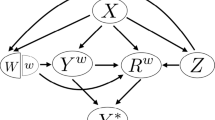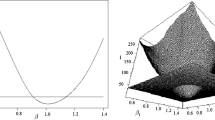Abstract
In this paper, we advance the application of empirical likelihood (EL) for missing response problems. Inspired by remedies for the shortcomings of EL for parameter hypothesis testing, we modify the EL approach used for statistical inference on the mean response when the response is subject to missing behavior. We propose consistent mean estimators, and associated confidence intervals. We extend the approach to estimate the average treatment effect in causal inference settings. We detail the analogous estimators for average treatment effect, prove their consistency, and example their use in estimating the average effect of smoking on renal function of the patients with atherosclerotic renal-artery stenosis and elevated blood pressure, chronic kidney disease, or both. Our proposed estimators outperform the historical mean estimators under missing responses and causal inference settings in terms of simulated relative RMSE and coverage probability on average.








Similar content being viewed by others
Data accessibility
The rest of the simulation data can be found in the supplementing materials. Access to CORAL data is upon request to MS. Pamela S. Brewster, pamela.brewster@utoledo.edu, and Dr. Christopher J. Cooper, christopher.cooper@utoledo.edu.
References
Chen J, Variyath AM, Abraham B (2008) Adjusted empirical likelihood and its properties. J Comput Graph Stat 17(2):426–443
Çınlar E (2011) Probability and Stochastics. Graduate Texts in Mathematics. Springer New York . https://books.google.com/books?id=7VtAx56r8CAC
Cooper CJ, Murphy TP, Cutlip DE, Jamerson K, Henrich W, Reid DM, Cohen DJ, Matsumoto AH, Steffes M, Jaff MR et al (2014) Stenting and medical therapy for atherosclerotic renal-artery stenosis. N Engl J Med 370(1):13–22
Davison AC, Hinkley DV (1997) Bootstrap methods and their application. 1. Cambridge University Press, Cambridge
DiCiccio TJ, Efron B (1996) Bootstrap confidence intervals. Stat Sci 11:189–212
Efron B (1987) Better bootstrap confidence intervals. J Am Stat Assoc 82(397):171–185
Guan Z, Qin J (2017) Empirical likelihood method for non-ignorable missing data problems. Lifetime Data Anal 23:113–135
Hahn J (1998) On the role of the propensity score in efficient semiparametric estimation of average treatment effects. Econometrica 66:315–331
Imbens GW, Rubin DB (2015) Causal inference in statistics, social, and biomedical sciences. Cambridge University Press, Cambridge
Muñoz JF, Rueda M (2014) Optimum design-based ratio estimators of the distribution function. J Appl Stat 41(7):1395–1407. https://doi.org/10.1080/02664763.2013.870983
Jing BY, Tsao M, Zhou W (2017) Transforming the empirical likelihood towards better accuracy. Can J Stat 45(3):340–352
Liang H, Wang S, Carroll RJ (2007) Partially linear models with missing response variables and error-prone covariates. Biometrika 94(1):185–198
Little RJ, Rubin DB (2019) Statistical analysis with missing data, vol 793. Wiley, New York
Little RJA, Rubin DB (1986) Statistical analysis with missing data. Wiley, New York
Owen AB (1988) Empirical likelihood ratio confidence intervals for a single functional. Biometrika 75(2):237–249
Owen AB (2001) Empirical likelihood. CRC Press, Boca Raton
Owen AB (2014) Empirical likelihood. American Cancer Society, New York
Qin J (1993) Empirical likelihood in biased sample problems. Ann Stat 21(3):1182–1196
Qin J, Lawless J (1995) Estimating equations, empirical likelihood and constraints on parameters. Can J Stat/Rev Can Stat 23(2):145–159
Qin J, Zhang B (2007) Empirical-likelihood-based inference in missing response problems and its application in observational studies. J R Stat Soc Ser B 69(1):101–122
Qin J, Zhang B, Leung DH (2009) Empirical likelihood in missing data problems. J Am Stat Assoc 104(488):1492–1503
Ren K, Drummond CA, Brewster PS, Haller ST, Tian J, Cooper CJ, Zhang B (2016) An alternative empirical likelihood method in missing response problems and causal inference. Stat Med 35(27):5009–5028
Robins JM, Rotnitzky A, Zhao LP (1994) Estimation of regression coefficients when some regressors are not always observedrobinsrotzhao1995. J Am Stat Assoc 89(427):846–866
Robins JM, Rotnitzky A, Zhao LP (1995) Analysis of semiparametric regression models for repeated outcomes in the presence of missing data. J Am Stat Assoc 90(429):106–121
Rosenbaum PR, Rubin DB (1983) The central role of the propensity score in observational studies for causal effects. Biometrika 70(1):41–55
Rubin DB (1974) Estimating causal effects of treatments in randomized and nonrandomized studies. J Educ Psychol 66(5):688
Rubin DB (1976) Inference and missing data. Biometrika 63(3):581–592
Rubin DB (1977) Assignment to treatment group on the basis of a covariate. J Educ Stat 2(1):1–26
Rubin DB (1978) Bayesian inference for causal effects: The role of randomization. Ann Stat 6:34–58
Rueda M, Martínez S, Martínez H, Arcos A (2006) Mean estimation with calibration techniques in presence of missing data. Comput Stat Data Anal 50(11):3263–3277
Serfling R (1980) Approximation theorems of mathematical statistics. Wiley, New York
Stute W, Xue L, Zhu L (2007) Empirical likelihood inference in nonlinear errors-in-covariables models with validation data. J Am Stat Assoc 102(477):332–346
Wang Q, Rao JNK (2002) Empirical likelihood-based inference under imputation for missing response data. Ann Stat 30(3):896–924
White H (1982) Maximum likelihood estimation of misspecified models. Econometrica 50(1):1–25
Wilks SS (1938) The large-sample distribution of the likelihood ratio for testing composite hypotheses. Ann Math Stat 1:60–62. https://doi.org/10.1214/aoms/1177732360
Acknowledgements
Dr. Sima Sharghi would like to acknowledge and thank the important part that Dr. Sally Thurston from University of Rochester has played for completion of this paper. Working under supervision of Dr. Thurston, supported by T32ES007271 NIEHS grant provided the means for completion of this research paper. The authors thank MS. Pamela S. Brewster, and Dr. Christopher J. Cooper from University of Toledo for generously allowing the use of the CORAL data. The authors are also very grateful for the anonymous reviewers and their comments. Their comments has shaped the paper to be more cohesive and clear.
Author information
Authors and Affiliations
Corresponding author
Additional information
Publisher's Note
Springer Nature remains neutral with regard to jurisdictional claims in published maps and institutional affiliations.
Rights and permissions
Springer Nature or its licensor (e.g. a society or other partner) holds exclusive rights to this article under a publishing agreement with the author(s) or other rightsholder(s); author self-archiving of the accepted manuscript version of this article is solely governed by the terms of such publishing agreement and applicable law.
About this article
Cite this article
Sharghi, S., Stoll, K. & Ning, W. Statistical inferences for missing response problems based on modified empirical likelihood. Stat Papers (2024). https://doi.org/10.1007/s00362-024-01553-1
Received:
Revised:
Published:
DOI: https://doi.org/10.1007/s00362-024-01553-1
Keywords
- Causal Inferences
- Adjusted Empirical Likelihood
- Transformed Empirical Likelihood
- Missing Response
- Propensity Score




